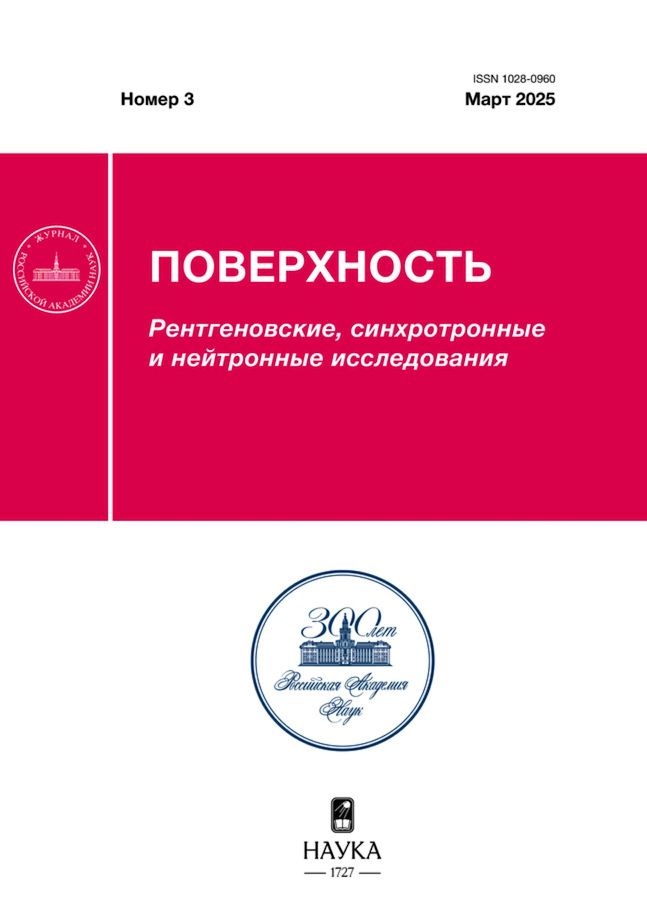Моделирование повреждений в полиэтилене вдоль траекторий быстрых тяжелых ионов
- Авторы: Бабаев П.А.1, Воронков Р.А.1, Волков А.Е.1,2
-
Учреждения:
- Физический институт имени П.Н. Лебедева РАН
- Национальный исследовательский центр “Курчатовский институт”
- Выпуск: № 4 (2025)
- Страницы: 56-62
- Раздел: Статьи
- URL: https://modernonco.orscience.ru/1028-0960/article/view/689153
- DOI: https://doi.org/10.31857/S1028096025040081
- EDN: https://elibrary.ru/FCAVCS
- ID: 689153
Цитировать
Полный текст
Аннотация
Представлены результаты моделирования образования на атомарном уровне повреждений вдоль всей траектории быстрых тяжелых ионов, тормозящих в режиме электронных потерь энергии в полиэтилене. Аналитические модели могли бы значительно улучшить понимание формирования треков в полимерах, но имеют своим главным недостатком низкий уровень детализации. В настоящей работе эта проблема решена с использованием мультимасштабной гибридной численной модели: методом Монте-Карло с помощью программы TREKIS описано возбуждение электронной системы материала; молекулярно-динамическое моделирование отклика атомной системы на внесенное налетающим ионом возмущение, реализованное в программе LAMMPS, позволило отслеживать повреждение вплоть до времен полного остывания трека. Детальное описание кинетики взаимодействующих электронной и атомной систем материала позволило продемонстрировать пространственное разделение положений максимумов повреждений и максимумов выделения энергии на траектории иона в полиэтилене на, по меньшей мере, 10 мкм. Различия обусловлены зависимостью начальных спектров электронов, генерируемых вблизи траектории иона, от энергии иона. Продемонстрированные эффекты должны проявляться в любых полимерах и могут иметь решающее значение для эффективной работы облучаемых быстрыми тяжелыми ионами устройств и детекторов, содержащих тонкие полимерные пленки.
Ключевые слова
Полный текст
Об авторах
П. А. Бабаев
Физический институт имени П.Н. Лебедева РАН
Автор, ответственный за переписку.
Email: babaevpa@lebedev.ru
Россия, Москва
Р. А. Воронков
Физический институт имени П.Н. Лебедева РАН
Email: babaevpa@lebedev.ru
Россия, Москва
А. Е. Волков
Физический институт имени П.Н. Лебедева РАН; Национальный исследовательский центр “Курчатовский институт”
Email: babaevpa@lebedev.ru
Россия, Москва; Москва
Список литературы
- Zhao S., Zhang G., Shen W., Wang X., Liu F. // J. Appl. Phys. 2020. V. 128. № 13. P. 131102. https://www.doi.org/10.1063/5.0015975
- Komarov F.F. // Physics-Uspekhi. 2017. V. 60. № 5. P. 435. https://www.doi.org/10.3367/ufne.2016.10.038012
- Medvedev N., Volkov A.E., Rymzhanov R., Akhmetov F., Gorbunov S., Voronkov R., Babaev P. // J. Appl. Phys. 2023. V. 133. № 10. P. 8979. https://www.doi.org/10.1063/5.0128774
- Liu F., Wang M., Wang X., Wang P. // Nanotechnology. 2018. V. 30. № 5. P. 052001. https://www.doi.org/10.1088/1361-6528/aaed6d
- Apel P. // Radiat. Phys. Chem. 2019. V. 159. P. 25. https://doi.org/10.1016/j.radphyschem.2019.01.009
- Fink D. // Springer Science & Business Media. 2004. V.63.
- Husaini S., Zaidi J., Malik F., Arif M. // Radiat. Meas. 2008. V. 4. P. S607. https://doi.org/10.1016/j.radmeas.2008.03.070
- Tuleushev A., Harrison F., Kozlovskiy A., Zdorovets M. // Polymers. 2023. V.15 №20. P. 4050. https://doi.org/10.3390/polym15204050
- Balanzat E., Betz N., Bouffard S. // Nucl Instrum Methods Phys Res B . 1995. V. 105. P.46. https://doi.org/10.1016/0168-583X(95)00521-8
- Shen W., Wang X., Zhang G., Kluth P., Wang Y., Liu F. // Nucl. Instrum. Methods Phys. Res. B. 2023. V. 535. P. 102. https://www.doi.org/10.1016/j.nimb.2022.11.021
- Kański M., Dawid M., Postawa Z., Ashraf M.C., van Duin A.C.T., Garrison B.J. // J. Phys. Chem. Lett. 2018. V. 9. Iss. 2. P. 359. https://www.doi.org/10.1021/acs.jpclett.7b03155
- Kański M., Hrabar S., van Duin A.C.T., Postawa Z. // J. Phys. Chem. Lett. 2022. V. 13. Iss. 2. P. 628. https://www.doi.org/10.1021/acs.jpclett.1c03867
- Medvedev N.A., Rymzhanov R.A., Volkov A.E. // J. Phys. D: Appl. Phys. 2015. V. 48. № 35. P. 355303. https://www.doi.org/10.1088/0022-3727/48/35/355303
- Rymzhanov R.A., Medvedev N.A., Volkov A.E. // Nucl. Instrum. Methods Phys. Res. B. 2016. V. 388. P. 41. https://www.doi.org/10.1016/j.nimb.2016.11.002
- Van Hove L. // Phys. Rev. 1954. V. 95. № 1. P. 249. https://www.doi.org/10.1103/PhysRev.95.249
- Palik E.D. Handbook of optical constants of solids. Academic press, 1997. 2008 p.
- Henke B.L., Gullikson E.M., Davis J.C. // Atomic data and nuclear data tables. 1993. V. 54. № 2. P. 181. https://www.doi.org/10.1006/adnd.1993.1013
- Ritchie R.H., Howie A. // Philos. Mag. 1977. V. 36. № 2. P. 463. https://www.doi.org/10.1080/14786437708244948
- Adachi S. The Handbook on Optical Constants of Semiconductors: In Tables and Figures. Singapore: World Scientific Publishing Company, 2012. 632 p.
- Powell C.J., Jablonski A. // J. Phys. Chem. Ref. Data. 1999. V. 28. № 1. P. 19. https://www.doi.org/10.1063/1.556035
- Jablonski A., Powell C.J. // J. Electron Spectros Relat. Phenomena. 2015. V. 199. P. 27. https://www.doi.org/10.1016/j.elspec.2014.12.011
- Ziegler J.P., Biersack U., Littmark J.F. The Stopping and Range of Ions in Solids. New York: Pergamon Press, 1985. 321 p.
- Medvedev N., Babaev P., Chalupský J., Juha L., Volkov A.E. // Phys. Chem. Chem. Phys. 2021. V. 23. № 30. P. 16193. https://www.doi.org/10.1039/D1CP02199K
- Jo S., Kim T., Iyer V.G., Im W. // J. Comput. Chem. 2008. V. 29. № 11. P. 1859. https://www.doi.org/10.1002/jcc.20945
- Abbott L.J., Hart K.E., Colina C.M. // Theor. Chem. Acc. 2013. V. 132. P. 1. https://www.doi.org/10.1007/s00214-013-1334-z
- Shirazi M.M.H., Khajouei-Nezhad M., Zebarjad S.M., Ebrahimi R. // Polym. Bull. 2020. V. 77. P. 1681. https://www.doi.org/10.1007/s00289-019-02827-7
- Berendsen H.J.C., Postma J.P.M., Gunsteren W.F., DiNola A., Haak J.R. // J. Chem. Phys. 1984. V. 81. № 8. P. 3684. https://www.doi.org/10.1063/1.448118
- Plimpton S. // J. Comput. Phys. 1995. V. 117. № 1. P. 1. https://www.doi.org/10.1006/jcph.1995.1039
- O′Connor T.C., Andzelm J., Robbins M. // J. Chem. Phys. 2015. V. 142. № 2. P. 024903. https://www.doi.org/10.1063/1.4905549
- Stukowski A. // Modelling Simul. Mater. Sci. Eng. 2009. V. 18. № 1. P. 015012. https://www.doi.org/10.1088/0965-0393/18/1/015012
- Rymzhanov R.A., Gorbunov S.A., Medvedev N., Volkov A.E. // Nucl. Instrum. Methods Phys. Res. B. 2019. V. 440. P. 25. https://www.doi.org/10.1016/j.nimb.2018.11.034
- Rymzhanov, R.A., Medvedev, N., Volkov, A.E. // J. Mater Sci. 2023. V. 58. P. 14072. https://www.doi.org/10.1007/s10853-023-08898-2
Дополнительные файлы
















